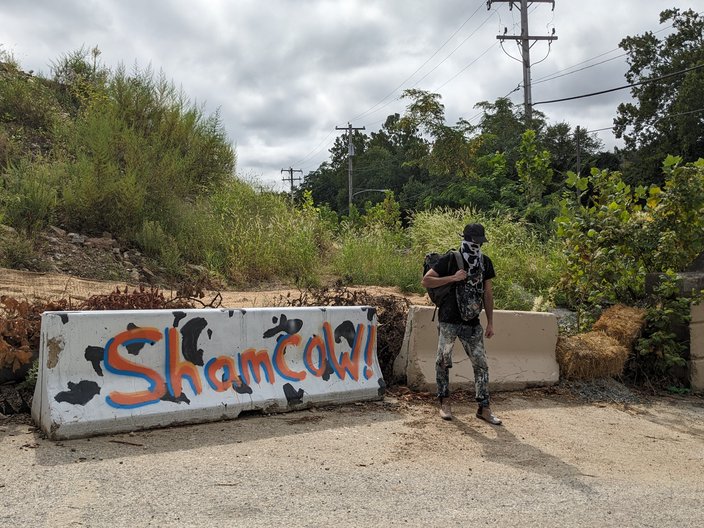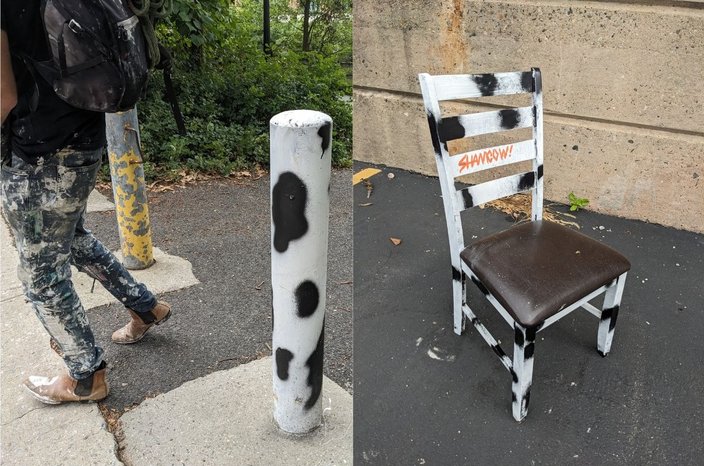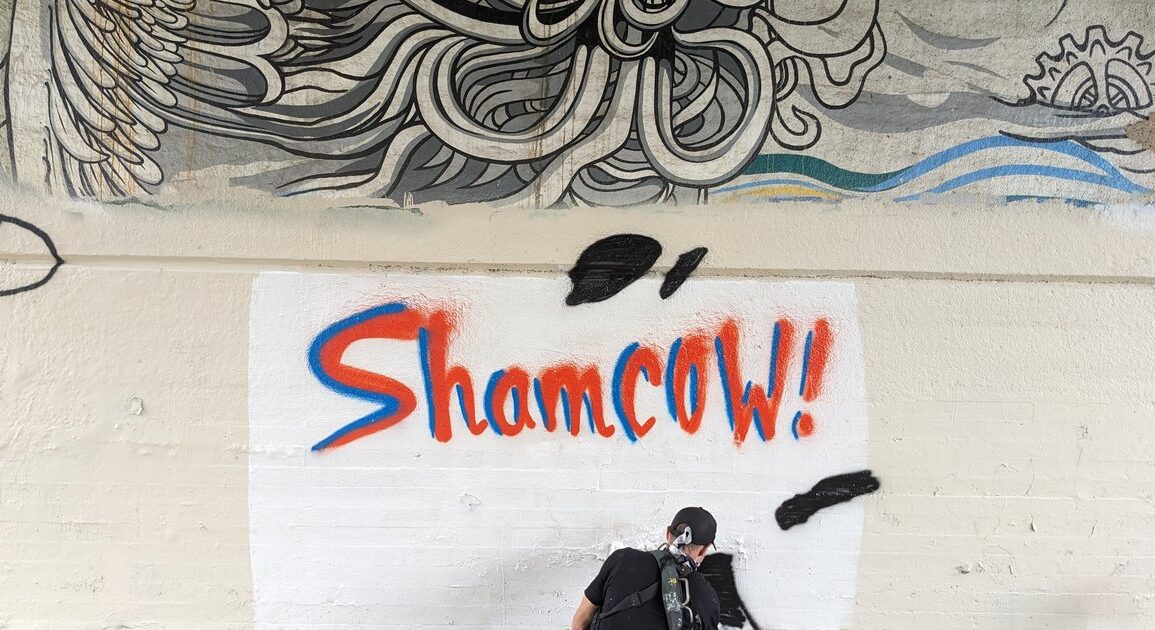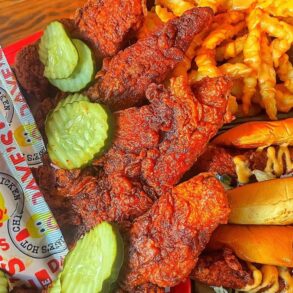After Emily Keine spotted black-and-white cow print graffiti on an Interstate 76 on-ramp leaving Roxborough, it wasn’t long before she started noticing similar street art around the area and began texting friends about each new sighting.
“I would be driving to work and I would see (the cow graffiti) and it would be a miserable day and it just got a little brighter,” said Keine, 26, from East Falls. “It just adds a little levity.”
MORE: Beloved MLK mural in West Philly will be restored on the building that obstructs it
The graffiti — which features a white background with black spots and the word “Shamcow” (a play on the ShamWow towel once advertised on a late-night infomercial) written in neon orange lettering with blue shadowing — has become a hot topic on the Roxborough neighborhood’s Rants & Raves Facebook page.
While some advocate for the illegal artwork to be painted over by the city, for others it sparks joy. It’s become so popular that it’s inspired commissioned paintings on trash cans and a barber pole, and there’s Shamcow merchandise for sale at the Pretzel Park Farmers Market in Manayunk.
Mentions of Shamcow in the neighborhood Facebook group became so frequent that moderators started to impose a “tax,” requiring a donation to Walter B. Saul High School for every post about the graffiti.
Keine falls into the pro-Shamcow camp. When she found an cow-print chair left on the side of the road, she messaged the artist’s Instagram account. He suggested she take it home and offered to sign it for her.
“I love it, I have so much animal print in my house, it’s perfect for me,” she said. “So I just feel so honored that he allowed me to pick it up.”
The birth of a moo-vement
The origin story of Shamcow is no grand marketing scheme or a statement piece on cows. It all began as an inside joke between the graffiti artist and his former girlfriend.
The artist, who spoke on the condition of anonymity because of the illegal nature of what he does, said often his paintings were being getting crossed out and painted over by other graffiti artists – a diss in the culture. In response, he put his background in rock climbing to good use and started leaving his mark high above where others could reach.
Eventually, his art started to gain the support of the community. He painted on concrete traffic barriers, porta-potties and a discarded couch. He even briefly had his stamp on the former Lobo Mau space on Sixth and Bainbridge streets in Queen Village.
When picking a spot to paint, Shamcow said he tries to cover up anything racist, profane or “just plain ugly.” The jersey barriers are his favorite because no one really cares about them and they’re more visible to drivers.
“If I’m putting the Shamcow there, it’s because whatever was there before wasn’t as nice,” he said. “I get that Shamcow might not be especially appealing to the eyes of everyone, but it’s better than what was there before and until you have a better idea, that’s what it’s going to be, Shamcow.”
 Michaela Althouse/PhillyVoice
Michaela Althouse/PhillyVoice
The Shamcow artist leaves his mark on a concrete barrier in Manayunk.
Gaining a cult following
Anthony Long, who moved to the area a year ago, said that finding the paintings became like an Easter egg hunt. He created the Shamcow website where fans can share photos and connected with the artist.
At around the same time, Shamcow was moving into the world of commissioned work, with people paying him to paint household items. In July, the two teamed up, with Long running the business end and creating a phone number at 1-833-Shamcow for commissions and information.
Long sees Shamcow as art that was “fun without trying to be fun,” he said.
“Typically, people just find joy in it, which that’s completely unheard of for graffiti, unless it’s a message like ‘Love yourself’ or ‘I love you’ with the candy hearts,” Long said, referring to the artist Amberella’s hearts, which have been popular in the city for years. “To just have a pattern and the word Shamcow and to get a response, and to have that response resonate with so many, is super interesting.”
Keine agreed, saying that pairing the bright print with such a familiar product feels clever and playful.
“There’s high contrast, so it catches your eye and it’s very harmless and pure,” Keine said. “It’s not something that’s really abrasive, and I think it just encapsulates what artwork in Philadelphia is about, which is just fun and keeping it light.”




The artist paints a pole along Main Street in Manayunk, and the chair Emily Keine found and took home.
Rants among the raves
Graffiti has a long history in Philly, starting with artist Darryl McCray, aka Cornbread, who is widely credited with starting the modern movement. In 1971, he famously spray-painted “Cornbread Lives” on an elephant at the Philadelphia Zoo.
But the strong ties to the culture doesn’t mean there’s complete support for all the graffiti that’s popping up around the city, including Shamcow’s work.
Joseph Zajko, the president of ZBC General Contracting, has lived in Roxborough for over 46 years and is a vocal opponent to the Shamcow graffiti. He doesn’t care if neighbors commission the artwork, but he views the rest as criminal behavior.
“You’ve got this guy who’s vandalizing buildings, vandalizing bridges, vandalizing public areas and they’re down there supporting them,” Zajko said. “It’s vandalism, the city should be arresting him, not supporting him.”
Robin Berg, of Manayunk, likes the artwork but prefers it in certain places.
“I like it in areas where it’s kind of deserted,” she said. “You don’t expect to see it and all of a sudden you come up against it, and that’s kind of interesting that’s where I would think it has the best impact.”
Philadelphia’s Community Life Improvement Program is responsible for removing graffiti around the city, and its director Tom Conway, said he expects his crews will clean graffiti from about 200,000 properties this year. Yet, Conway recognizes there’s a difference between a graffiti tagger scribbling his initials, who’s being disruptive, and elaborate art that requires more time and skill.
He has worked with Mural Arts, to encourage more planned and sanctioned art instead of just tagging a building in the middle of the night.




The artists sets up to create his Shamcow graffiti.
“We channeled our energies in the positive and worked with the community on creating murals and designs,” Conway said. “You’ll see a lot of them along rail lines. … But the graffiti tagger, just vandalism, destruction of property, I’m not for that at all.”
Whether or not people like the Shamcow graffiti isn’t as important to Long the fact that they’re talking about it.
“Some people don’t agree that it’s art, which is interesting because they have the emotion,” Long said. “It may not be a positive emotion, but they still get angry, they still get perturbed or upset, which is exactly what art is supposed to do. So a lot of the times, they’re telling us that it’s not art, while they’re affected by the art.”
Turning art into a cash cow
Long said the moderators of the neighborhood Facebook page have raised a few hundred dollars for Walter B. Saul High, the agricultural magnet school in Roxborough, with its tax on Shamcow posts and comments. Also a percentage of the Shamcow merchandise sales benefit the school, too, and the artist will be painting a barn at the campus on Henry Avenue.
“It sounds cliche, but he’s got a heart of gold,” Long said. “I’ve seen the way that the art touches people.”
Outside Roxborough and Manayunk, Shamcow’s work has appeared in Center City, East Falls, Germantown and even New Jersey. The artist also was hired to paint a barn in Luzerne County, near Scranton.
There was a Shamcow signature drink at Unity Java, and Twisted Gingers Brewing Co. in Manayunk will release an IPA inspired by the graffiti artist next month. Shamcow has received requests for Christmas ornaments and a Halloween costume, and this fall he’s hoping to do some spin-offs: shamcat and downward dog.
The artist isn’t sure whether he’ll ever reveal his identity, although he said a number of people already know. He said it’s hard to guess if the mystery adds to the brand’s popularity, or if revealing himself would expand the public image. In the long run, he doesn’t expect Shamcow to go away, although he thinks the spotlight will eventually dim.
In the meantime, he and Long will keep bringing the art to the community.
“I don’t know how far I could take it, but as long as opportunities present themselves, we’ll explore,” he said.
This post was originally published on this site be sure to check out more of their content.









